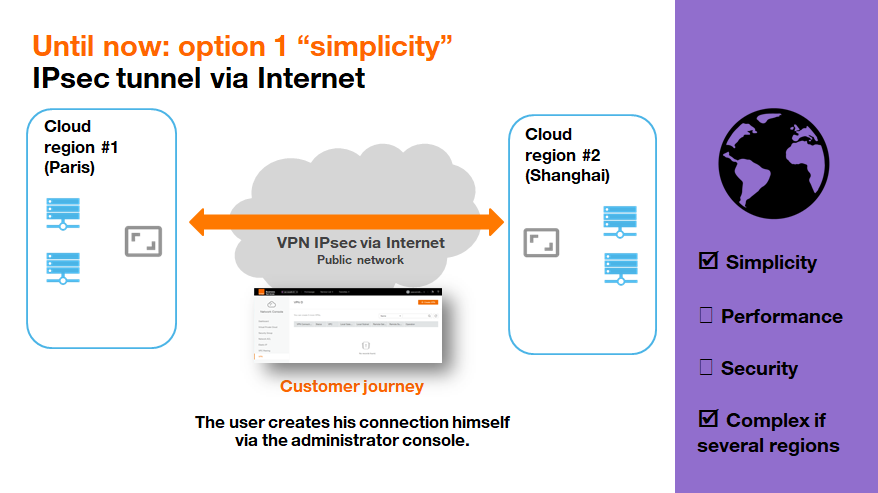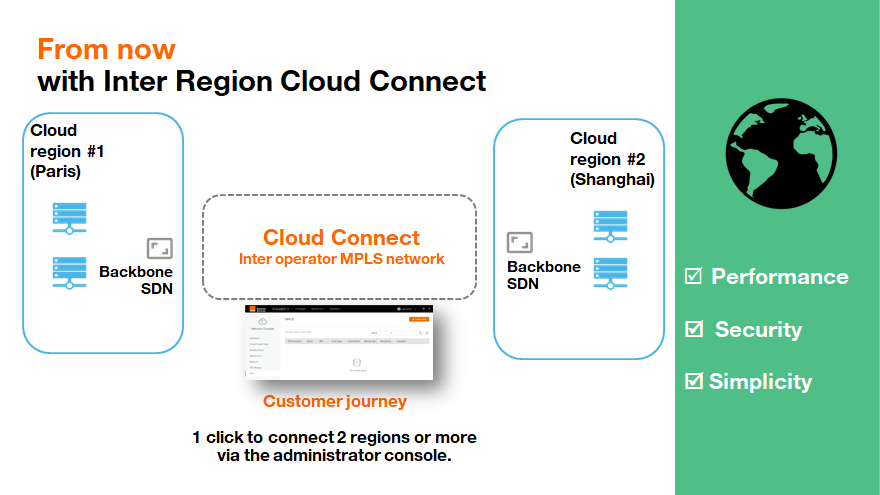First classic option: the IPsec cloud connection via Internet
How is a world-class cloud built? It’s done by leveraging local infrastructure and enterprise and cloud operators, and marrying different models to optimize business in a multi-region strategy. For example, to communicate and share data, the company traditionally sets up an Internet connection via an IPsec VPN tunnel. But if the approach is simple, the deployment of these connections is complex in multi-regions. The link is subject to many hazards, including the very essence of the Internet – a public information network that’s accessible to all and is supported by the networks of operators.

Option 1 (Before): Inter-Cloud Connection via an IPsec and Internet VPN Link
This solution is not satisfactory. It integrates with global Internet traffic routed by the different operators that make up its path, with the accompanying risks of unpredictability of performance. The Internet also exposes the company to the threat of cyber attacks, especially by denial of service, and more generally by the inability to unify the quality of service across the cloud chain, where the Internet cannot guarantee end-to-end performance. The company does not fully control the promised SLA.
Second classic option: inter-regional connection in MPLS networks
A secure and efficient inter-regional connection solution that does not rely on the Internet does exist. The world is wired with fibers, which operators rely on to support the clouds of various organizations. Take the example of a cloud that extends from Paris to Shanghai. For its cloud infrastructure, the network administrator will be able to rely on a private and individual connection that relies on secure MPLS network operators. In our example, the connection starts from the virtual private network of a French operator (Orange) via a gateway located in Hong Kong (Huawei), to the equivalent network of a Chinese operator (China Telecom). With four connections established on two operators, the performance is at the rendezvous and the connection is secure. However, the operation remains complex and the agility sought is not optimal.

Option 2 (Before): Inter-Regional Cloud Connection via a Private MPLS Link
Today's solution: inter-regional cloud connection
To set up a direct private connection, the company must have a global cloud composed of two regions connected by a single, powerful and secure backbone, which supports local particularities such as openness to access and compliance with regulations. This can only be made possible by creating a unique inter-regional cloud network that aggregates the private MPLS networks of partner operators. For example, consider a cloud that extends from France to China, with a Cloud Alliance-based project (including Huawei Cloud, China Telecom, Telefonica, T-system and Orange Business). In this case, the enterprise cloud administrator has a single backbone and a network of connections that it deploys with a single click and administers on a single, centralized console.
This inter-regional cloud connection solution therefore presents the simplicity and security sought by companies and their cloud administrators, as well as the performance of an infrastructure that makes it possible to have a direct MPLS backbone line on the fiber of the partner operators. With its local operator partner, via its administration console, the company can, with one click, create a connection between two regions and extend its cloud infrastructure, or simply connect existing cloud infrastructures.

Today: Cloud Connection via One-Click Cloud Connect
Connecting inter-regional clouds
Behind the connection of cloud infrastructure hides a vital process of the economy: the private exchange of data between organizations and clouds. A strategic process that must provide a response tailored to the bandwidth, latency and availability reduction needs, new digital services, and cybersecurity across the company's digital networks. Brad Casemore, Research Director, IDC Data Center Networks, noted "the growing importance of the need to address the problem of proximity to digital services in all sectors." The analyst has estimated that bandwidth for interconnections is expected to increase by 45% per year by 2020. Bob Gill, from Gartner, author of the report Colocation-Based Interconnection Will Serve as the "Glue" for Advanced Digital Business Applications, believes that, "The dynamism and speed of these connections will accelerate the development of even more useful applications."
In conclusion, the compromise experienced by companies between performance, simplicity and security in their deployments on the cloud between several regions, for example France and China, is resolved via the technological partnerships between cloud operators.
Learn more about creating a multi-cloud migration plan here.

As Product Owner of Flexible Engine, I manage the Orange Business cloud infrastructure solution designed in partnership with Huawei.
Passionate about digital transformation and Open Innovation, with rich experience in its fields, I lead French and Chinese multidisciplinary teams to accelerate innovation and the launch of infrastructure solutions on the corporate market by pooling R&D (Research & Development) and technologies. One of my challenges: to deepen my knowledge of Chinese culture.